COVID Stories: Sourdough bread with a purpose
Organic chemistry lab mates Carolyn Hong and Brendan Huang used their love of science and bread to learn to make sourdough, which they sell, giving Feeding America the profits.
March 23, 2021
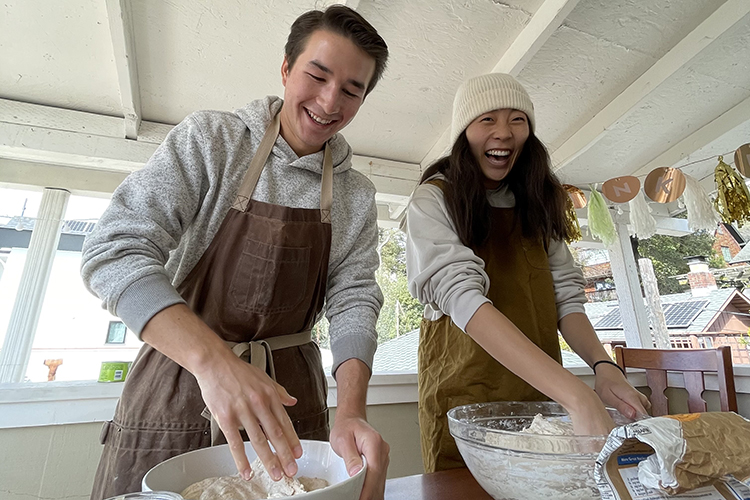
Seniors Brendan Huang and Carolyn Hong, who both have received the COVID-19 vaccine and are in the same social bubble, met in an organic chemistry lab as sophomores, became fast friends and wound up baking sourdough bread together. It’s an adventure that Hong calls “our sourdough journey.” (Photo by Talia Patt)
The COVID-19 pandemic has separated us, but sharing stories about how members of the campus community have been surviving — and even thriving — since last spring can help draw us together. Berkeley News is gathering inspiring personal tales of heartache and triumph related to the coronavirus and will run them periodically in the coming weeks. If you’d like to pitch us your story, send a brief email to [email protected]. Check out the whole series here.
This is the eighth story in the series. It highlights undergraduates Carolyn Hong and Brendan Huang, who will graduate in May.
Friends Carolyn Hong and Brendan Huang had a delicious dilemma. Last semester, the UC Berkeley seniors’ freezers were overstuffed with sourdough bread. They’d taught themselves to bake it — increasingly, to perfection — during the COVID-19 pandemic, which set off a nationwide bread baking craze, and, initially, a shortage of flour and yeast.
At Hong’s house, which she rents with friends near Berkeley’s Clark Kerr campus, flour coated the kitchen, all available Mason jars and Tupperware contained starter, bowls of dough proofed in the refrigerators, and browned and crackly-crusted loaves nested in multiple Dutch ovens.
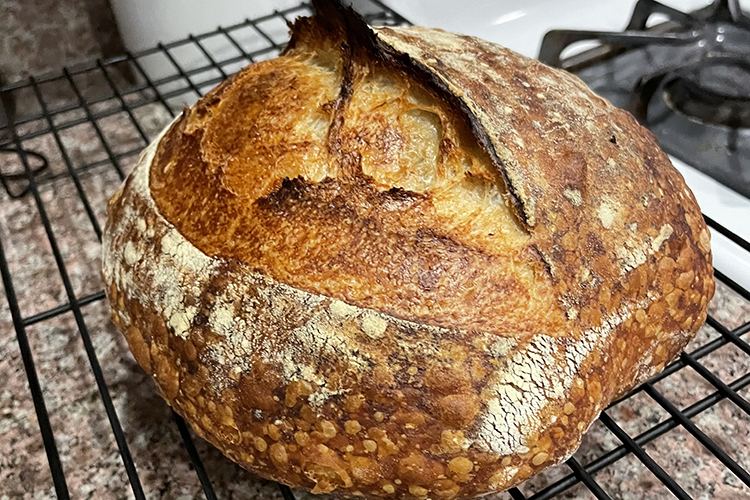
Loaves of sourdough bread packing the freezers of friends Brendan Huang and Carolyn Hong led them to sell it to friends and donate the profits, minus the cost of flour, to Feeding America. (Photo by Carolyn Hong)
Their roommates were supportive, but occasionally struggled to adjust. Once, when Hong’s dough bulk ferment was resting in the oven, with no heat or lights on inside, “my roommate turned the oven on without telling me, and I burned my dough,” she said.
“It definitely had become an addiction,” admitted Huang. “We wanted to continue baking, but we had nowhere to put it.”
Still, there was no turning back for the former organic chemistry lab mates, who embarked a year ago on what Hong calls “our sourdough journey.”
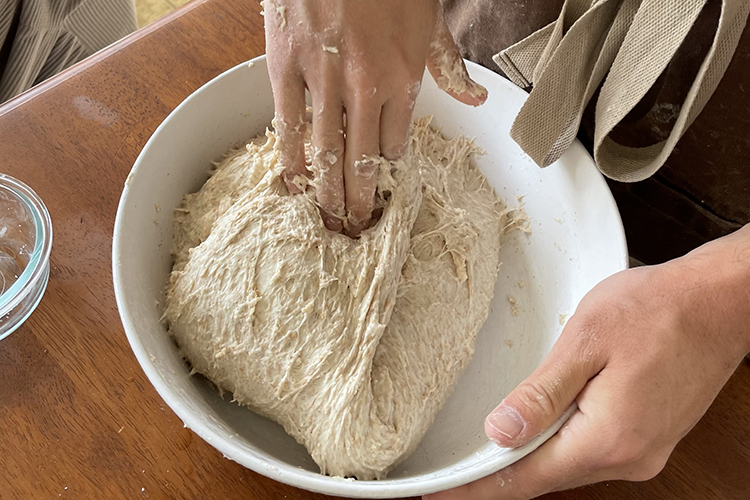
Instagram posts of people’s photos of and advice about bread baking, a national obsession during the coronavirus pandemic helped inspire Carolyn Hong to try her hand at baking bread. Her friend Brendan Huang joined her. (Photo by Carolyn Hong)
Friends suggested they sell their bread, which is visually and gastronomically appealing. “But I wasn’t comfortable with selling for a profit,” said Hong. Neither was Huang.
Then, a young woman Hong had “friended” on Instagram gave her the idea of selling her bread and donating the money to a cause. During the Black Lives Matter movement, the Chicagoan had churned out banana bread pudding and given the profits to BLM organizations.

As they built their bread-making skills, Brendan Huang and Carolyn Hong would simultaneously bake sourdough bread in their own kitchens, sending each other photos to compare notes. In the evening, they’d share their loaves outdoors with roommates. (Photo by Talia Patt)
“So, we decided to charge $10 a loaf and subtract the price of flour and donate whatever is remaining to Feeding America,” said Hong. “We’ve donated close to $300, which Feeding America says translates to 3,000 meals for families in need, which is pretty amazing.”
Huang said he and Hong “love attaching notes to our deliveries, reminding people of their impact” on fighting hunger.
A ‘low stakes/high rewards chemistry experiment’
It was Berkeley alumna, chef and food writer Samin Nosrat — her “Salt, Fat, Acid, Heat” book and Netflix series by the same name are big hits — who inspired Hong at the start of the pandemic to start cooking and try new recipes. Hong said she became “obsessed” with Nosrat’s four-part documentary TV series.
“I love that Samin went to Cal. I even met her randomly at Willard Park last July,” said Hong. “I think I said, ‘Hi, I’m such a big fan,’ and told her I made her buttermilk-marinated roasted chicken. She was so sweet and seemed to be eager to talk to fans about her work. I said I went to Berkeley, like she did, and I took a photo from 6 feet away.”
The sourdough bread that was being made by an increasing number of Instagram followers, who were posting photos and descriptions of their experiments with it during the pandemic, also captivated Hong, a chemistry major.
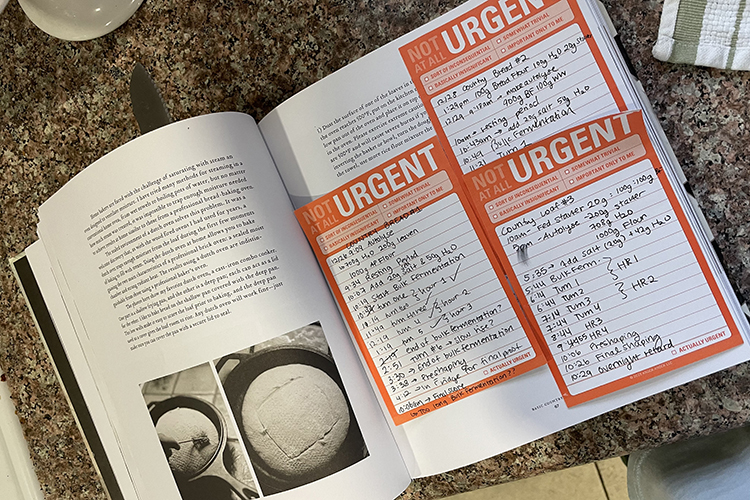
The science majors, who met in an organic chemistry lab, each tried many recipes, watched videos and baked countless loaves to perfect their sourdough baking craft. (Photo by Carolyn Hong)
“I wanted to know, ‘What is starter? How do I begin?’” she said. “I had tried to make bagels, I’d tried making pretzels, but I was intrigued by how big a process it is to make sourdough.”
Meanwhile, Hong discovered that Huang, a chemical and biomolecular engineering major, had the same interest in sourdough, as well as a copy of Nosrat’s book, which includes terms familiar to chemistry students. Hong and Huang met sophomore year in a Chem 12B lab and became “very fast friends,” said Huang.
The two were surprised at the overlap between chemistry and cooking, said Hong, and “joked that baking sourdough would be a low stakes/high reward chemistry experiment.”
In winter 2019-20, Huang began baking sourdough. Unable to regularly find active dry yeast to buy, he decided to make his own starter. A steep learning curve followed.

Brendan Huang shows three of the sourdough rounds that resulted from many months of trial and error. He and fellow baker Carolyn Hong sell the bread to friends, then donate the proceeds to charity, minus the cost of flour. (Photo by Carolyn Hong)
“Baking sourdough was a challenge — it would randomly fail for reasons that took me a while to figure out,” he said. “But I have experience with fermentation and cell culture, so baking naturally-fermented bread at home was a very cool way to work with and apply the basic principles of fermentation I was learning about in class at a smaller scale at home. And, I love eating bread.”
Meanwhile, Hong, who initially sheltered in place with her family in Los Angeles last spring after Berkeley ended in-person instruction, said she read New York Times’ food writer Claire Saffitz’s bread- and bagel-making guides, watched her YouTube videos and “went on a craze of my own.”
When she returned to Berkeley last July, she produced her first loaf of homemade sourdough bread. She and Huang then began “baking simultaneously in our own kitchens and sent each other photos.” In the evenings, they’d test their wares out roommates in their backyards, adhering to COVID-19 safety precautions.
Hong also created an Instagram account, where she continues to chronicle her progress with bread baking, sharing her struggles and triumphs with crumb, proofing, hydration levels and experiments with flavored loaves.
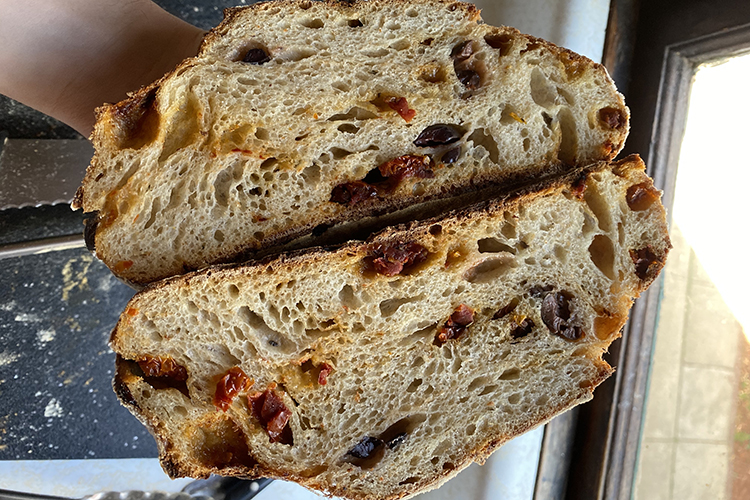
An addition to the bakers’ repertoire is a sourdough loaf containing sun-dried tomatoes and olives. (Photo by Brendan Huang)
The journey’s rewards
From fall semester on, baking sourdough bread has given the friends more than culinary know-how and tasty round loaves.
Hong not only discovered a stay-at-home hobby to keep her focused, “because I love running around,” she said, “but a passion that I was able to do with one of my first friends at Cal, and then transform it into something we could give away.”
She and Huang take bread orders, package the loaves in cellophane and yarn, and then enjoy walking around Berkeley to deliver them, often to friends they don’t get to see much otherwise, during the pandemic. They are careful to wear masks and gloves and to greet their customers from a distance.
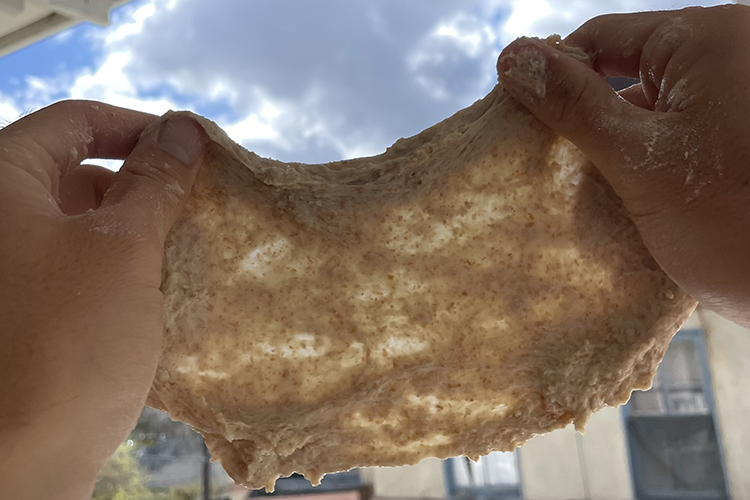
Carolyn Hong said that learning to bake bread was more than a stay-at-home hobby. It became “a passion that I was able to do with one of my first friends at Cal, and then transform it into something we could give away.” (Photo by Carolyn Hong)
“You can specify when you want a loaf delivered, but if I have an exam or am really busy, I skip a week, so baking doesn’t become unenjoyable,” said Hong. “After spring break, we’ll probably bake once or twice more before we graduate. We’re still trying to bake every week.”
Said Huang, “Our order form usually maxes out in under an hour.”
They’ve introduced a flavored loaf flecked with sun-dried tomatoes and olives, and they plan to experiment this week during spring break with making olive and rosemary sourdough bread.
Donating the profits “was always the plan,” said Huang. “I’m not sure we would have sold our bread otherwise. It’s a great way to keep working on baking sourdough, without overflowing our freezers, all the while making a positive impact.”